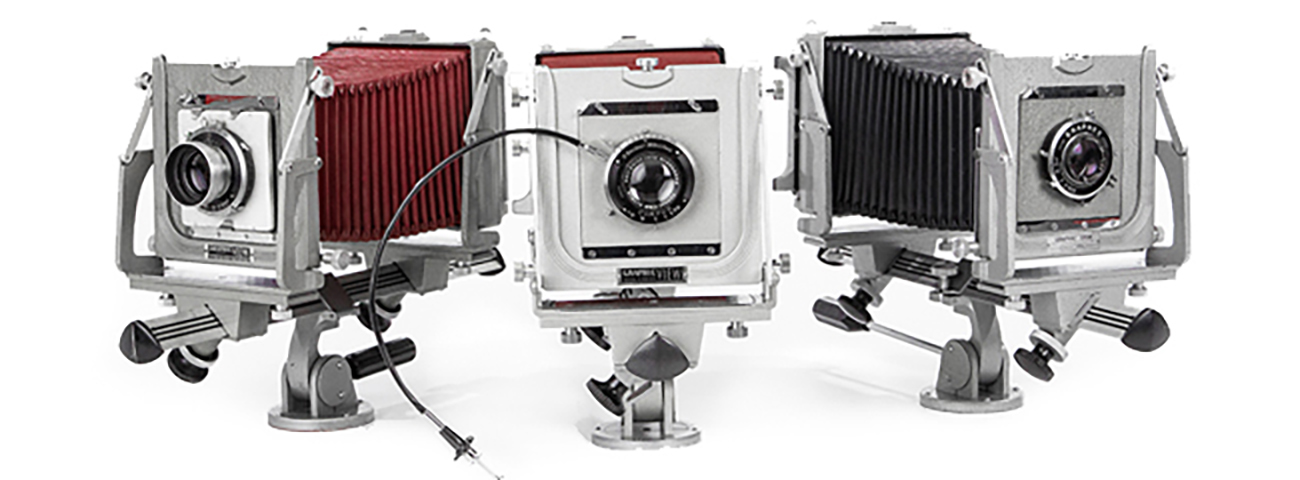
Pictured above is an early 1940s Graphic View I (center), a 1950s Graphic View II (left), and a 1960s Graphic View II (right) with late model black bellows.
 Introduced just prior to World War II the Graphic View benefited from the advancements in lightweight metal alloys made during the early part of the twentieth century. In fact, such a camera may not have been possible just a decade earlier.
Introduced just prior to World War II the Graphic View benefited from the advancements in lightweight metal alloys made during the early part of the twentieth century. In fact, such a camera may not have been possible just a decade earlier.
You could describe the Graphic View as being an early player in the Mid-Century Modern movement. Launched in 1941, the stylish, yet minimal, monorail camera was a major departure from its predecessors, the Mahogany and brass studio cameras such as the Crown View it replaced. The sturdy body and durable bellows made the Graphic View Camera a workhorse of photography. It was a successful design, produced over a long period and in great quantities for professional studio photographers.
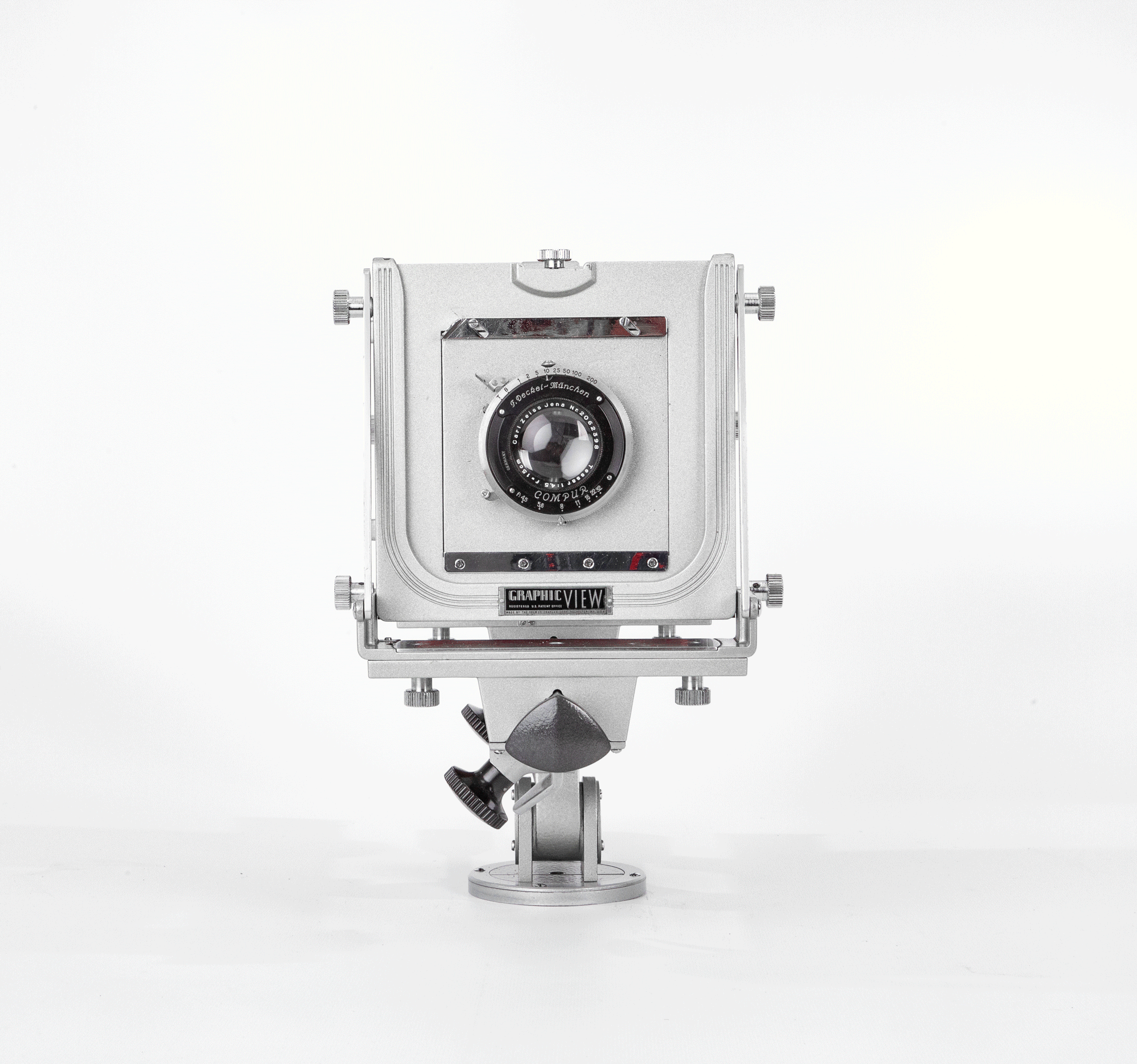 The Graphic View is mostly comprised of various chromed parts and a lightweight, yet strong, painted aluminum alloy body. Featuring an inverted “V” monorail mounting system with a rack and pinion hidden within the rail for detailed focus. It attaches to a tripod with the proprietary tripod mount that grips around the monorail allowing for quick placement at any point along the rail. This makes possible a monorail camera that can still compress standards tight together for extreme wide-angle photography, or open up for telephoto use. The camera has tilt/shift/rotate abilities for both standards, and a built-in bubble level above the rear film standard. The first version featured a basic gray paint, while the second model introduced in 1949 has the trademark hammered look gray paint. The cameras are probably best known for their long-lasting rubber/cloth bellows. Red bellows were typical except for a few with black bellows made for military contracts, and those produced with black bellows near the end of the production cycle in the 1960s.
The Graphic View is mostly comprised of various chromed parts and a lightweight, yet strong, painted aluminum alloy body. Featuring an inverted “V” monorail mounting system with a rack and pinion hidden within the rail for detailed focus. It attaches to a tripod with the proprietary tripod mount that grips around the monorail allowing for quick placement at any point along the rail. This makes possible a monorail camera that can still compress standards tight together for extreme wide-angle photography, or open up for telephoto use. The camera has tilt/shift/rotate abilities for both standards, and a built-in bubble level above the rear film standard. The first version featured a basic gray paint, while the second model introduced in 1949 has the trademark hammered look gray paint. The cameras are probably best known for their long-lasting rubber/cloth bellows. Red bellows were typical except for a few with black bellows made for military contracts, and those produced with black bellows near the end of the production cycle in the 1960s.
The Graphic View I, as it would later be called after the release of the Graphic View II, was innovative; however, as with most new designs the first version had some issues. The most prominent challenge was the offset cantilever locking mechanism. After focusing the camera, the photographer would place pressure on the monorail to hold the standards in place by swinging a small lever under the rail. This locking lever had a rounded end with an offset axis. As the lever rotated the offset would cause a greater area of the lever to be pushed against the locking plate under the rail. However, there was nothing to hold the position other than friction between the slick chrome lever and metal pressure plate. Often the lock would loosen and the standard slide prior to exposure. This issue was quickly identified, and an upgraded locking mechanism was offered to owners of the Graphic View I. The replacement locking system was so embraced that today it may be hard to find a Graphic View I with the original locking levers. The replacement system became stock on the Graphic View II, and used a round rotating ring adjacent to the rail focus knobs to hold the standards during exposure.
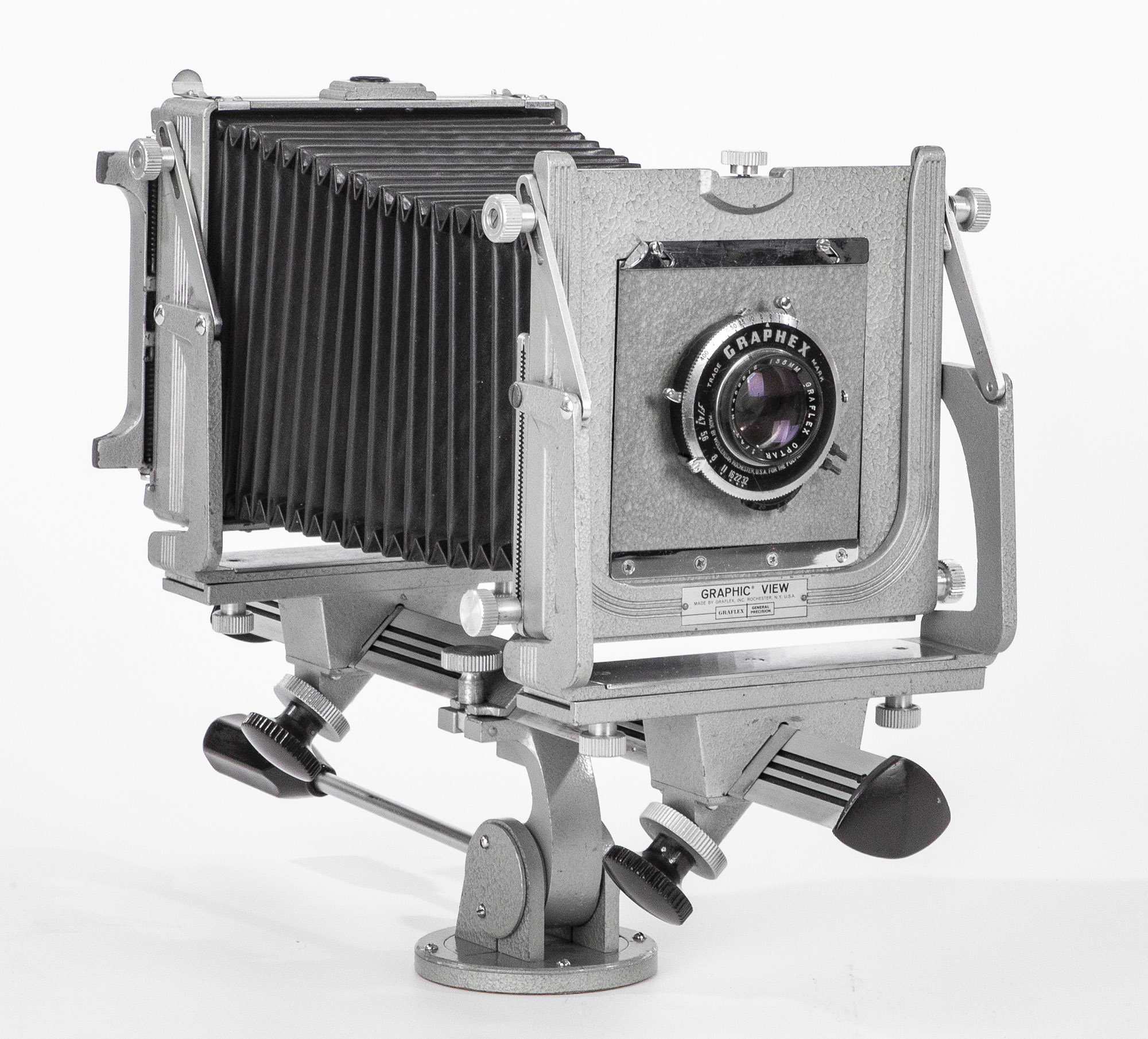 Another highly noticeable change between the version I and II cameras is how the standards tilt. In the Graphic View I the lens board and film standards pivoted at their base. This meant the lens or film moved forward or back in relation to each other when tilted, and required refocusing the camera. Having the pivot at the base of the standard was a simple design, but this complicated the use of the camera, including exposer calculations due to the lens moving closer or away from the film. Unveiled in 1949 the Graphic View II had a mid-standard universal center pivot, thus allowing the lens or film plane to tilt and rotate from the center axis point for optimal composition without changing the center axis distance between the film and lens. The left/right shift for both standards was a success from the very first camera and went unchanged during the long production run of the Graphic View.
Another highly noticeable change between the version I and II cameras is how the standards tilt. In the Graphic View I the lens board and film standards pivoted at their base. This meant the lens or film moved forward or back in relation to each other when tilted, and required refocusing the camera. Having the pivot at the base of the standard was a simple design, but this complicated the use of the camera, including exposer calculations due to the lens moving closer or away from the film. Unveiled in 1949 the Graphic View II had a mid-standard universal center pivot, thus allowing the lens or film plane to tilt and rotate from the center axis point for optimal composition without changing the center axis distance between the film and lens. The left/right shift for both standards was a success from the very first camera and went unchanged during the long production run of the Graphic View.
In 1947 Graflex introduced one of the best known features of 4 x 5 view cameras… the Graflok Back. Prior to its introduction, if you wished to change film backs (sheet, half sheet, roll, polaroid, and such) you needed a camera back made specifically for each camera you owned. However with the Graflok back, you just needed to have the back for your camera that featured the Graflok quick release ground glass. This standardized various 4 x 5 film backs to the Graflok design. Such a successful modification that from that point to this day, most view cameras have used the Graflok mounting system. Toyo recently introduced the new digital view camera, Toyo View VX23D, featuring the Graflok rear mount over 70 years after the original introduction of the universal film mount system.
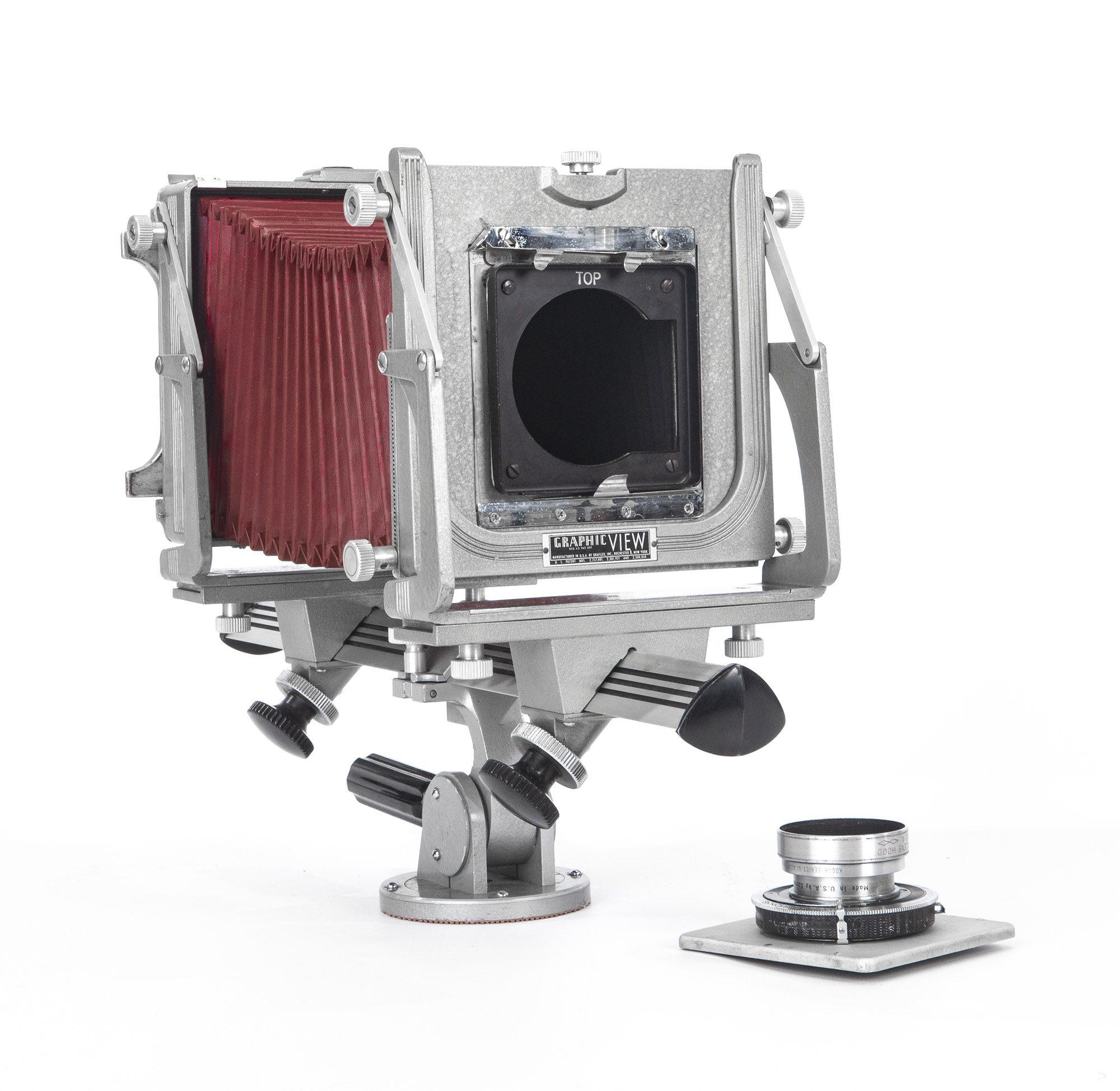 Graflex was also smart when it came to lens mounts. The Graphic View featured a generic lens board that could be used to mount the lens of your choice. The metal 4 x 4 inch board was designed to be small for modern lenses, while strong to hold heavy professional glass without warping. However, for many years prior and concurrent with the camera, Graflex was known for a line of successful field cameras such as the Speed Graphic. Most professional photographers probably already owned one of these cameras, often referred to as press cameras, and would not be excited about purchasing duplicate lenses or removing the lens from an existing lens board. To that end Graflex offered an adapter lens board that allowed for the easy use of lenses already mounted on Speed Graphic style boards. This simple adapter was immensely successful and few Graphic View photographers went without one.
Graflex was also smart when it came to lens mounts. The Graphic View featured a generic lens board that could be used to mount the lens of your choice. The metal 4 x 4 inch board was designed to be small for modern lenses, while strong to hold heavy professional glass without warping. However, for many years prior and concurrent with the camera, Graflex was known for a line of successful field cameras such as the Speed Graphic. Most professional photographers probably already owned one of these cameras, often referred to as press cameras, and would not be excited about purchasing duplicate lenses or removing the lens from an existing lens board. To that end Graflex offered an adapter lens board that allowed for the easy use of lenses already mounted on Speed Graphic style boards. This simple adapter was immensely successful and few Graphic View photographers went without one.
It is worth noting that, though innovative and successful, the Graphic View was not the first monorail camera. In fact you can see the many similarities between the Graphic View and the still wooden and hand-made, 1927 Stegemann Studien-Kamera C from Germany. However, due to the uncommon 9 x 12 inch plate size and obvious financial limitations brought on by the Great Depression, the Studeien-Kamera C was probably never sold in any meaningful numbers, even in Germany.
Graphic View Camera
Manufacturer: Graflex Corporation
Production: 1941 – 1967
Type: View Camera
Media: 4×5 sheet film, 120 roll film, modern digital backs and more.
Lens: Varies as chosen by photographer.
Focus: Highly variable with rotating, tilting & shifting standards
Accessories:
- Graflok Back
- Flat as well as inset lens boards
- Compendium lens shade hood
- Graflex lens board adapter
Collectability:
The Graphic View Camera was a benchmark along the evolution of large format photography equipment, scoring an 80 out of a 100 on the collectability scale. These cameras dont rank higher for a couple reasons, first is that they were popular cameras produced over a long period in great quantities, limiting the rarity factor. Second is the fact they are still seen by many as a usable camera and often bought by hobbyists wanting to get a start in 4 x5 large format photography. The heavy weight bellows have proven the ability to withstand the years if properly cared for, and the Graphic View II with it’s universal tilt-shift design coupled with a Graflok back, can accomplish everything most cameras 50 years newer can. Though still probably one of the best buys in 4 x 5 large format cameras, their unique place on the timeline of cameras, retro mid-century styling, usability, coupled with a renewed interest in large format photography means that prices are rising.
Photographer: John Baltz
 John is a seasoned professional with nearly 30 years in photography. A native to Northwest Arkansas, John’s first interest in photography began with collecting cameras as a child from antique markets around town. Later, John received a degree in Computer Science from the University of Arkansas. It is his strong knowledge in digital photography, along with a love for the the history of photography that provides for a unique sense of creativity driving many of his projects.
John is a seasoned professional with nearly 30 years in photography. A native to Northwest Arkansas, John’s first interest in photography began with collecting cameras as a child from antique markets around town. Later, John received a degree in Computer Science from the University of Arkansas. It is his strong knowledge in digital photography, along with a love for the the history of photography that provides for a unique sense of creativity driving many of his projects.
Bibliography
Camera Wiki – http://camera-wiki.org/wiki/Graphic_View_cameras
Greg-Neville.com – https://greg-neville.com/tag/stegemann-studien-kamera-c/
Graflex.org – https://www.graflex.org/articles/graphic-view/index.html
Largeformatphotography.info – https://www.largeformatphotography.info/speed-graphic-FAQ.html#Introduction
The 4×5 Graflex View Camera – https://lommen9.home.xs4all.nl/view/index.html
Other Classic Cameras
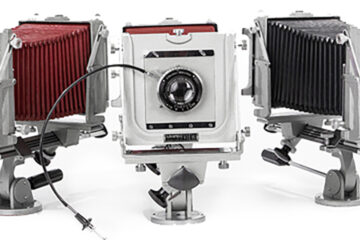
Graphic View Camera
Introduced just prior to World War II the Graphic View benefited from the advancements in lightweight metal alloys made during…
Read more
Graphic 35 Jet
Introducing the world’s first, and only jet-powered camera, the Graphic Jet 35! Designed by the American camera company Graflex and…
Read more
Konica C35 AF
Sometimes milestone advancements are found in some of the most unexpected cameras. That is certainly true of the Konica C35…
Read more
Linex Stereo Camera
Why do collectors find the Linex camera so intriguing? In part because it is a crossover piece. An item of…
Read more
